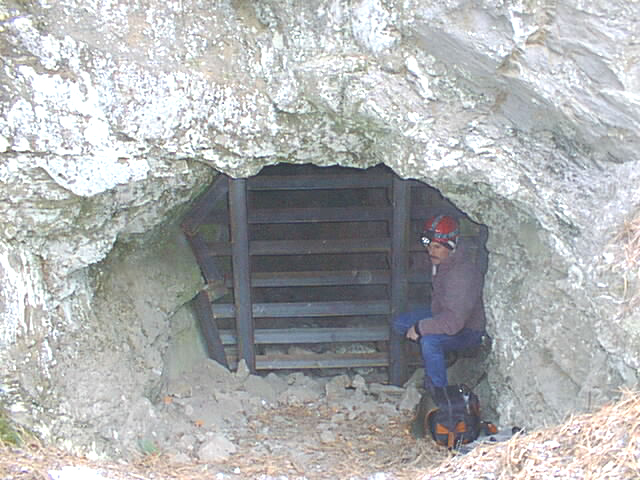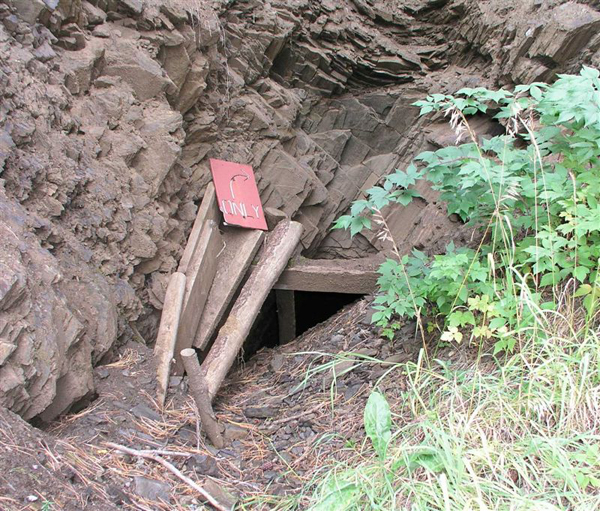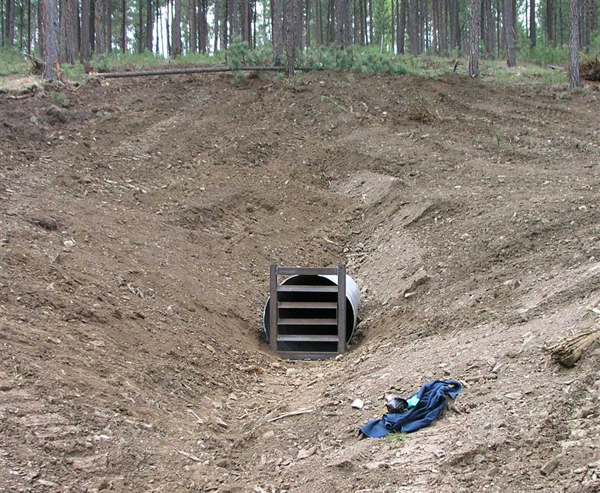South
Dakota Bat Working Group
Bats
& Mines
Last update 12/2009

Updated December 2009
Abandoned
Mines Are Wildlife Habitat
By Joel
Tigner of Batworks - A Chiropteran Consultancy
Generally speaking, open underground abandoned mines are viewed as blight
on the landscape. In the Black Hills region, open underground
mines have been part of the terrain for over one hundred years. As such,
they have come to serve as an integral part of sustaining habitat for
many wildlife species, including South Dakota’s bats. At least ten
species of bats roost in underground mines in South Dakota. Bats live
in a variety of locations that can vary by season. These locations are
called roosts. Unlike many birds, bats do not build nests, so a bat roost
is not a nest, but rather a location where bats gather temporarily.
Bats…who needs them anyway? And on top of that, why don’t
they roost where they did before the mines were here? Abandoned mines
can pose public safety hazards!
All the bats in South Dakota eat nothing but insects. And bats
are insect-eating machines. Many of the insects that bats eat are agricultural
and forestry pests. Bats are the main predator of night-flying insects.
Bats also eat nuisance insects and help to control insects such as mosquitoes
that can impact public health. Many species can eat their weight in insects
during an evening. (One local example: During a survey at a roost in the
Black Hills, a Townsend’s Big-eared Bat was netted emerging at sunset.
The bat was weighed, banded, and released. Less than three hours later,
this same bat was captured re-entering the roost with a 40% increase in
body weight.) Without bats, insect populations would increase, largely
unchecked. An effective natural control, bats live only where the insect
population will support them.
The roosting question is more complex. There is virtually no
historical information on bat population size and distribution in South
Dakota. This notwithstanding, many of the naturally occurring underground
roosting sites (natural caves) have been lost as bat habitat (commercial
development of large caves, high levels of disturbance in natural caves).
Many of South Dakota's abandoned mines have likely served as a buffer
against the decline of available natural roosting sites. Bat surveys of
underground roosts begun in the early 1990’s have shown significant
declines in bat numbers when compared with surveys conducted at the same
sites since 2000. While a variety of factors have likely contributed to
the decline in bat numbers, disturbance at and loss of roosting sites
is a main cause of this decline.
Safety hazards? Absolutely, no question about it. All
abandoned mines can pose significant safety hazards. Underground mines
can be particularly dangerous places. In addition to the more obvious
hazards, collapse and fall hazards for example, many abandoned underground
mines contain toxic gases. Many of these are colorless, odorless and heavier
than air. They can accumulate at low places within the mine or pool along
the floor of the mine. A person entering the mine walking through these
pooled gases can stir them up into the good air being breathed where they
are inhaled. Conditions can change over time within the mine. Lacking
adequate ventilation, air quality will deteriorate. Previous visits into
a site are no guarantee that conditions will not have deteriorated to
lethal levels.
Abandoned mine entry should only be undertaken by trained individuals
using appropriate safety equipment.
Assessing abandoned mines and protecting them, where appropriate, serves
to mitigate these hazards.
At some point during the year, at least ten bat species
in South Dakota depend on underground roosting sites. Many abandoned mines
have been closed in recent years, either intentionally or through natural
erosion and /or deterioration. Not all mines, just as not all caves, provide
the conditions bats need to survive. Using SDGFP funding, abandoned mines
can be evaluated as bat habitat. In circumstances where the habitat is
determined to be significant, specially designed bat gates can be installed
to protect the roost for bats. These gates are designed to prevent unauthorized
human entry, mitigating liability for the landowner while providing “bat-friendly”
access. If the landowner decides to close open underground workings, advice
can be provided as to how and when this should be done to prevent unnecessarily
putting bats at risk. All of these are done at no cost to the landowner.
No property rights are affected by this program. If the
site is used by bats as a hibernation site, owners must agree to refrain
from entry of the site during the hibernation season. Each site is evaluated
on a case-by-case basis.
For additional information
on participation in this project,
Contact: Joel Tigner at joeltigner@gmail.com
605-390-2061 (Rapid City, South Dakota).


We are actively seeking locations of mines that provide potential roosting habitat in the Black Hills region. Site evaluation can be provided at no cost to individuals interested in determining whether their site(s) provide potential roosting habitat. There is no obligation or further commitment required to participate in this service. Should you elect to permanently close an underground site, advice and protocol can be given to prevent placing bats unnecessarily at risk.
Gating Information - Updated Dec. 25th, 2008
At the end of 2008, a total of 38 bat gates have been installed to protect
underground bat roosting habitat in the Black Hills region (31 at
abandoned mines; 7 at natural caves). All of these locations are used
by bats as hibernation sites as well as night roosts during the active
season. Sites are located on private and public land and are
located in Lawrence, Meade, Pennington, and Custer Counties in SD with
one mine located in Wyoming.
Currently, there are 5 gates pending construction in the Spring of 2009,
all of which are located at abandoned mines on private property. Evaluation
of newly identified sites continues through funding provided through SD
Department of Game, Fish and Parks.
in the Hell Canyon Ranger District of the Black Hills National Forest.
 Photo by Joel Tigner |
Photo by Brad Phillips |
For additional information or to report a location, contact:
Joel Tigner, BATWORKS
605-390-2061 (Rapid City)
joeltigner@gmail.com
Photos by Joel Tigner
